2010年AACE AME ETA甲状腺结节诊治指南.
- 格式:doc
- 大小:4.32 MB
- 文档页数:29
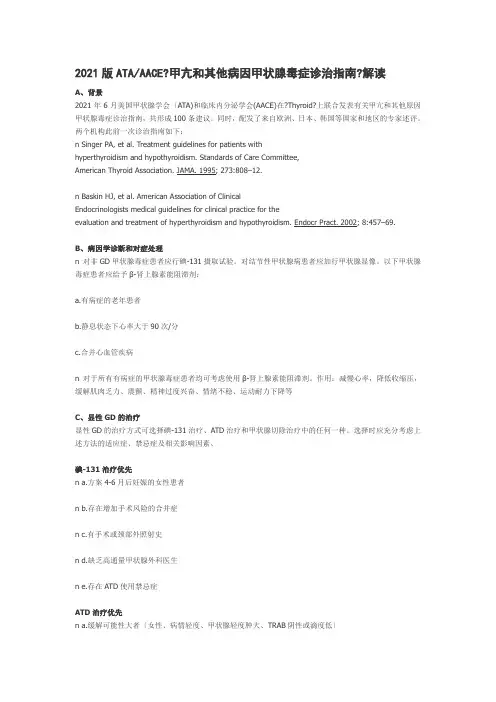
2021版ATA/AACE?甲亢和其他病因甲状腺毒症诊治指南?解读A、背景2021年6月美国甲状腺学会〔ATA)和临床内分泌学会(AACE)在?Thyroid?上联合发表有关甲亢和其他原因甲状腺毒症诊治指南,共形成100条建议。
同时,配发了来自欧洲、日本、韩国等国家和地区的专家述评。
两个机构此前一次诊治指南如下:n Singer PA, et al. Treatment guidelines for patients withhyperthyroidism and hypothyroidism. Standards of Care Committee,American Thyroid Association. JAMA. 1995; 273:808–12.n Baskin HJ, et al. American Association of ClinicalEndocrinologists medical guidelines for clinical practice for theevaluation and treatment of hyperthyroidism and hypothyroidism. Endocr Pract. 2002; 8:457–69.B、病因学诊断和对症处理n 对非GD甲状腺毒症患者应行碘-131摄取试验。
对结节性甲状腺病患者应加行甲状腺显像。
以下甲状腺毒症患者应给予β-肾上腺素能阻滞剂:a.有病症的老年患者b.静息状态下心率大于90次/分c.合并心血管疾病n 对于所有有病症的甲状腺毒症患者均可考虑使用β-肾上腺素能阻滞剂。
作用:减慢心率,降低收缩压,缓解肌肉乏力、震颤、精神过度兴奋、情绪不稳、运动耐力下降等C、显性GD的治疗显性GD的治疗方式可选择碘-131治疗、ATD治疗和甲状腺切除治疗中的任何一种。
选择时应充分考虑上述方法的适应症、禁忌症及相关影响因素、碘-131治疗优先n a.方案4-6月后妊娠的女性患者n b.存在增加手术风险的合并症n c.有手术或颈部外照射史n d.缺乏高通量甲状腺外科医生n e.存在ATD使用禁忌症ATD治疗优先n a.缓解可能性大者〔女性、病情轻度、甲状腺轻度肿大、TRAB阴性或滴度低〕n b.老年、存在增加手术风险的合并症或生存期有限n c.无法遵守辐射平安规定的护理人员n d.有手术或颈部外照射史n e.缺乏高通量甲状腺外科医生n f.中、重度活动性GO手术治疗优先n a.有压迫病症或巨大甲状腺肿〔≥80 g〕n b.摄碘率相对较低〔<40%〕n c.疑心或已确诊甲状腺恶性肿瘤n d.无功能结节n e.伴发需要手术治疗的甲旁亢n f.方案在4-6月内妊娠者〔尤其是TRAB显著升高者〕n g.中、重度活动性GO禁忌症n 碘-131:妊娠、泌乳、伴发甲状腺癌、不能遵守辐射平安规定、方案在4-6月内妊娠n ATD:主要副作用n 手术:严重伴发疾病〔心功能减退、晚期癌症、衰竭〕;妊娠的第一、三阶段影响因素n 碘-131:注重根治甲亢、防止手术和ATD的潜在副作用;轻视终生甲状腺素替代、立即解除甲亢、GO 的发生和加重的潜在可能n ATD:注重缓解的可能和防止终生甲状腺素替代、手术和辐射;轻视ATD的潜在副作用、持续监测和复发可能n 手术:注重立即根治甲亢、防止辐射和ATD的潜在副作用;轻视手术风险和终生甲状腺素替代D、碘-131治疗GD治疗前准备n 对于由于甲亢加重〔病症突出或游离T4大于正常值上限2-3倍〕导致并发症发生风险增加者,应在碘-131治疗前给予β-肾上腺素能阻滞剂。
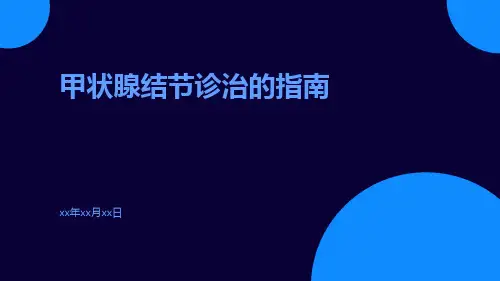
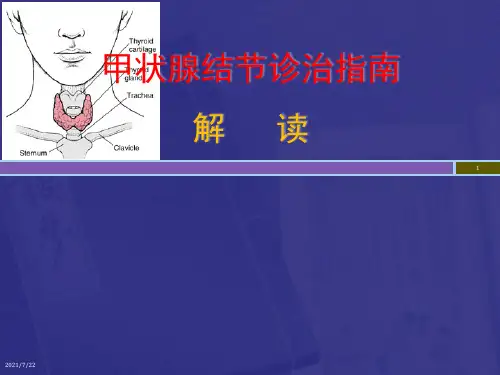
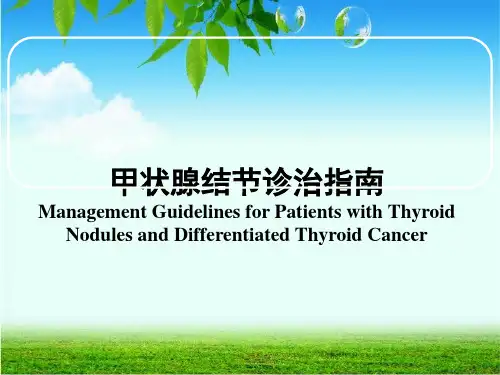
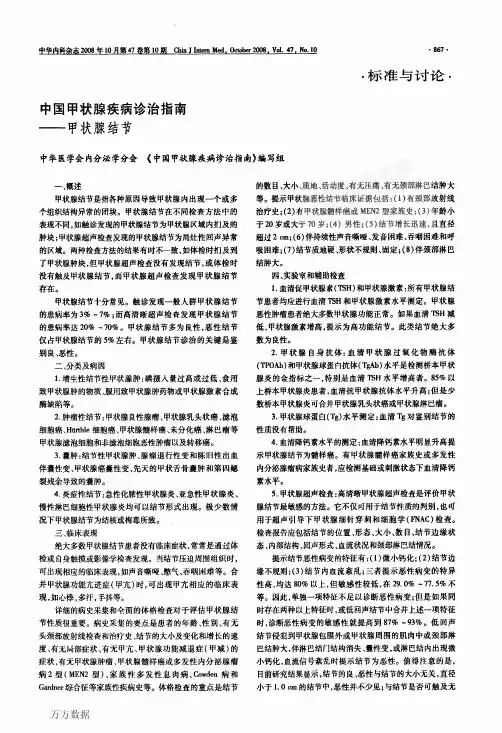
中国甲状腺疾病诊治指南——甲状腺结节中华医学会内分泌学分会《中国甲状腺疾病诊治指南》编写组一、概述甲状腺结节是指各种原因导致甲状腺内出现一个或多个组织结构异常的团块。
甲状腺结节在不同检查方法中的表现不同,如触诊发现的甲状腺结节为甲状腺区域内扪及的肿块;甲状腺超声检查发现的甲状腺结节为局灶性回声异常的区域。
两种检查方法的结果有时不一致,如体检时扪及到了甲状腺肿块,但甲状腺超声检查没有发现结节,或体检时没有触及甲状腺结节,而甲状腺超卢检查发现甲状腺结节存在。
甲状腺结节十分常见。
触诊发现一般人群甲状腺结节的患病率为3%一7%;而高清晰超声检查发现甲状腺结节的患病率达20%一70%。
甲状腺结节多为良性,恶性结节仅占甲状腺结节的5%左右。
甲状腺结节诊治的关键是鉴别良、恶性。
二、分类及病因1.增生性结节性甲状腺肿:碘摄入量过高或过低、食用致甲状腺肿的物质、服用致甲状腺肿药物或甲状腺激素合成酶缺陷等。
2。
肿瘤性结节:甲状腺良性腺瘤、甲状腺乳头状癌、滤泡细胞癌、Httrthle细胞癌、甲状腺髓样癌、未分化癌、淋巴瘤等甲状腺滤泡细胞和非滤泡细胞恶性肿瘤以及转移癌。
3.囊肿:结节性甲状腺肿、腺瘤退行性变和陈旧性出血伴囊性变、甲状腺癌囊性变、先天的甲状舌骨囊肿和第四鳃裂残余导致的囊肿。
4.炎症性结节:急性化脓性甲状腺炎、亚急性甲状腺炎、慢性淋巴细胞性甲状腺炎均可以结节形式出现。
极少数情况下甲状腺结节为结核或梅毒所致。
三、临床表现绝大多数甲状腺结节患者没有临床症状,常常是通过体检或自身触摸或影像学检查发现。
当结节压迫周围组织时,可出现相应的临床表现,如声音嘶哑、憋气、吞咽困难等。
合并甲状腺功能亢进症(甲亢)时,可出现甲亢相应的临床表现,如心悸,多汗,手抖等。
详细的病史采集和伞面的体格检查对于评估甲状腺结节性质很重要。
病史采集的要点是患者的年龄、性别、有无头颈部放射线检查和治疗史、结节的大小及变化和增长的速度、有无局部症状、有无甲亢、甲状腺功能减退症(甲减)的症状,有无甲状腺肿瘤、甲状腺髓样癌或多发性内分泌腺瘤病2型(MEN2型)、家族性多发性息肉病、Cowden病和Gardner综合征等家族性疾病史等。
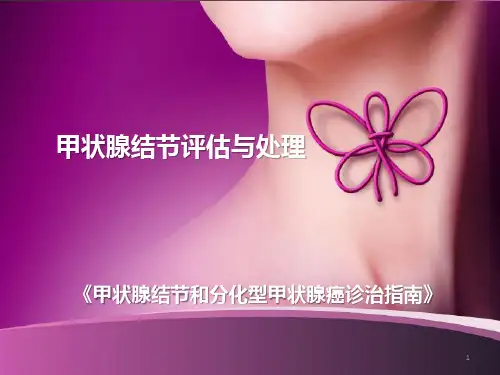
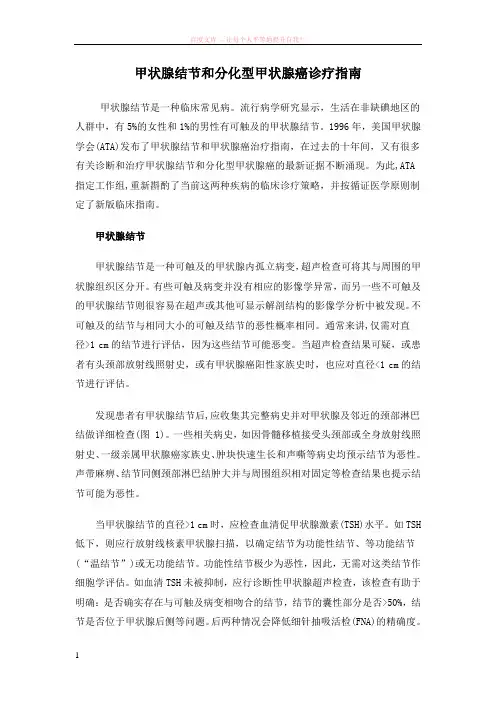
甲状腺结节和分化型甲状腺癌诊疗指南甲状腺结节是一种临床常见病。
流行病学研究显示,生活在非缺碘地区的人群中,有5%的女性和1%的男性有可触及的甲状腺结节。
1996年,美国甲状腺学会(ATA)发布了甲状腺结节和甲状腺癌治疗指南,在过去的十年间,又有很多有关诊断和治疗甲状腺结节和分化型甲状腺癌的最新证据不断涌现。
为此,ATA 指定工作组,重新斟酌了当前这两种疾病的临床诊疗策略,并按循证医学原则制定了新版临床指南。
甲状腺结节甲状腺结节是一种可触及的甲状腺内孤立病变,超声检查可将其与周围的甲状腺组织区分开。
有些可触及病变并没有相应的影像学异常,而另一些不可触及的甲状腺结节则很容易在超声或其他可显示解剖结构的影像学分析中被发现。
不可触及的结节与相同大小的可触及结节的恶性概率相同。
通常来讲,仅需对直径>1 cm的结节进行评估,因为这些结节可能恶变。
当超声检查结果可疑,或患者有头颈部放射线照射史,或有甲状腺癌阳性家族史时,也应对直径<1 cm的结节进行评估。
发现患者有甲状腺结节后,应收集其完整病史并对甲状腺及邻近的颈部淋巴结做详细检查(图 1)。
一些相关病史,如因骨髓移植接受头颈部或全身放射线照射史、一级亲属甲状腺癌家族史、肿块快速生长和声嘶等病史均预示结节为恶性。
声带麻痹、结节同侧颈部淋巴结肿大并与周围组织相对固定等检查结果也提示结节可能为恶性。
当甲状腺结节的直径>1 cm时,应检查血清促甲状腺激素(TSH)水平。
如TSH 低下,则应行放射线核素甲状腺扫描,以确定结节为功能性结节、等功能结节(“温结节”)或无功能结节。
功能性结节极少为恶性,因此,无需对这类结节作细胞学评估。
如血清TSH未被抑制,应行诊断性甲状腺超声检查,该检查有助于明确:是否确实存在与可触及病变相吻合的结节,结节的囊性部分是否>50%,结节是否位于甲状腺后侧等问题。
后两种情况会降低细针抽吸活检(FNA)的精确度。
即便TSH升高,也建议行FNA,因为正常甲状腺组织与桥本甲状腺炎累及组织中结节的恶变率相似。
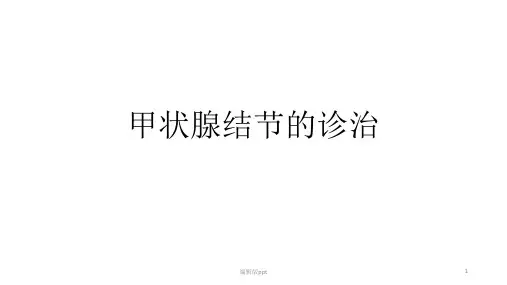
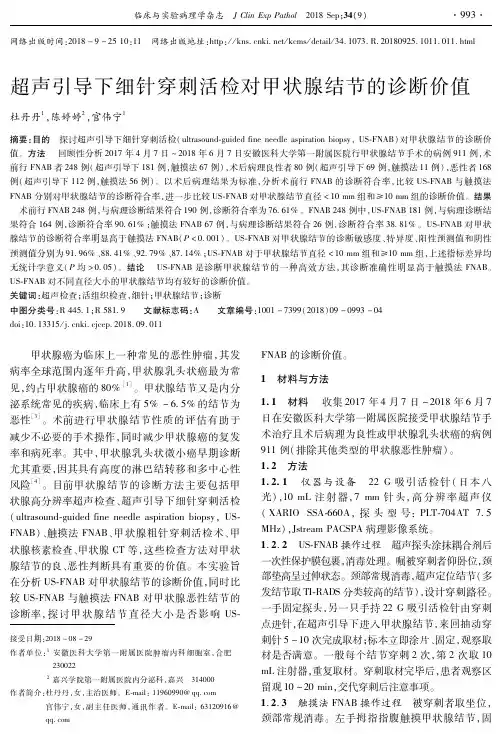
网络出版时间:2018-9-2510:11 网络出版地址:http://kns.cnki.net/kcms/detail/34.1073.R.20180925.1011.011.html超声引导下细针穿刺活检对甲状腺结节的诊断价值杜丹丹1,陈婷婷2,官伟宁1摘要:目的 探讨超声引导下细针穿刺活检(ultrasound guidedfineneedleaspirationbiopsy,US FNAB)对甲状腺结节的诊断价值。
方法 回顾性分析2017年4月7日~2018年6月7日安徽医科大学第一附属医院行甲状腺结节手术的病例911例,术前行FNAB者248例(超声引导下181例,触摸法67例),术后病理良性者80例(超声引导下69例,触摸法11例),恶性者168例(超声引导下112例,触摸法56例)。
以术后病理结果为标准,分析术前行FNAB的诊断符合率,比较US FNAB与触摸法FNAB分别对甲状腺结节的诊断符合率,进一步比较US FNAB对甲状腺结节直径<10mm组和≥10mm组的诊断价值。
结果 术前行FNAB248例,与病理诊断结果符合190例,诊断符合率为76 61%。
FNAB248例中,US FNAB181例,与病理诊断结果符合164例,诊断符合率90 61%;触摸法FNAB67例,与病理诊断结果符合26例,诊断符合率38 81%。
US FNAB对甲状腺结节的诊断符合率明显高于触摸法FNAB(P<0 001)。
US FNAB对甲状腺结节的诊断敏感度、特异度、阳性预测值和阴性预测值分别为91 96%、88 41%、92 79%、87 14%;US FNAB对于甲状腺结节直径<10mm组和≥10mm组,上述指标差异均无统计学意义(P均>0 05)。
结论 US FNAB是诊断甲状腺结节的一种高效方法,其诊断准确性明显高于触摸法FNAB。
US FNAB对不同直径大小的甲状腺结节均有较好的诊断价值。
关键词:超声检查;活组织检查,细针;甲状腺结节;诊断中图分类号:R445 1;R581 9 文献标志码:A 文章编号:1001-7399(2018)09-0993-04doi:10.13315/j.cnki.cjcep.2018.09.011接受日期:2018-08-29作者单位:1安徽医科大学第一附属医院肿瘤内科细胞室,合肥 2300222嘉兴学院第一附属医院内分泌科,嘉兴 314000作者简介:杜丹丹,女,主治医师。
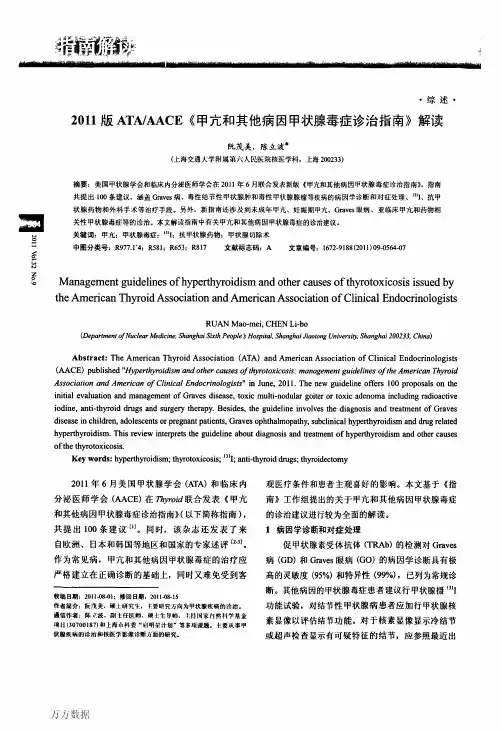
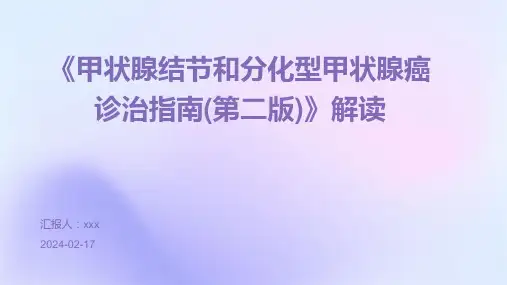
以7种不同甲状腺影像报告和数据系统鉴别桥本甲状腺炎背景下甲状腺良、恶性结节孙鑫;张巍;程令刚;广旸;张雨康【期刊名称】《中国医学影像技术》【年(卷),期】2024(40)2【摘要】目的比较7种不同甲状腺影像报告和数据系统(TI-RADS)用于鉴别桥本甲状腺炎(HT)背景下甲状腺良、恶性结节的价值。
方法纳入200例HT患者共338个甲状腺结节,良性167个、恶性171个。
分别采用Kwak-TIRADS、美国甲状腺学会(ATA)指南、美国临床内分泌医师协会(AACE)/美国内分泌协会(ACE)/意大利内分泌协会(AME)指南、韩国甲状腺放射学会K-TIRADS、欧洲甲状腺协会EU-TIRADS、美国放射协会(ACR)-TIRADS、中华医学会超声医学分会浅表器官和血管组《2020甲状腺结节超声恶性危险分层的中国指南》(C-TIRADS)对甲状腺结节进行分类;以病理结果为金标准,评估各TI-RADS的诊断效能。
结果Kwak-TIRADS、ATA指南、AACE/ACE/AME指南、K-TIRADS、EU-TIRADS、ACR-TIRADS及C-TIRADS鉴别HT背景下甲状腺良、恶性结节的敏感度分别为97.08%、98.25%、99.42%、95.91%、99.42%、90.06%及99.42%,特异度依次为88.02%、83.23%、82.04%、88.02%、82.04%、86.83%及84.43%,曲线下面积(AUC)分别为0.946、0.913、0.907、0.934、0.909、0.916及0.960。
C-TIRADS、EU-TIRADS及AACE/ACE/AME指南的敏感度均高于K-TIRADS和ACR-TIRADS(P均<0.05),Kawk-TIRADS和K-TIRADS的特异度均高于C-TIRADS、ATA指南、EU-TIRADS及AACE/ACE/AME指南(P均<0.05),C-TIRADS和Kawk-TIRADS的AUC均高于其他TI-RADS(P均<0.05)。
2016版《甲状腺结节超声诊断指南》与《甲状腺影像报告及数据系统诊断标准》在甲状腺结节诊断中对比研究王萍;刘健;岳文胜;罗玉群;李祖坤【期刊名称】《实用医学影像杂志》【年(卷),期】2018(019)001【摘要】目的对比分析2016美国临床内分泌协会(AACE)/美国内分泌学院(ACE)/内分泌学相关医学指南(AME)甲状腺超声诊断指南与甲状腺影像学报告及数据系统(TI-RADS)诊断标准对甲状腺结节良恶性的诊断价值.方法按TI-RADS分类系统中的评分标准评分,以病理检查结果为金标准,回顾性分析150例患者共203个甲状腺结节的二维超声及彩色多普勒超声检查结果,采用MecNemar检验及构建患者的工作特征(re-ceiver operating characteristic,ROC)曲线比较分析2016AACE/ACE/AME甲状腺超声诊断指南与TI-RADS分类系统对甲状腺良恶性结节的超声诊断意义.结果恶性结节75个,良性结节128个,2种评价方法对比分析,2016AACE/ACE/AME甲状腺超声诊断指南的灵敏度、特异度及准确度分别为84%、83%和84%,TI-RADS的敏感度、特异度及准确度分别为84%、61%和76%,2016AACE/ACE/AME甲状腺超声诊断指南对甲状腺结节诊断的特异度、准确度要高于TI-RADS,2种方法比较差异无统计学意义(P>0.05),但2种方法结合后,ROC曲线下面积为0.911,特异度、准确度及诊断价值高于单一方法.结论2016AACE/ACE/AME版甲状腺超声诊断指南在甲状腺结节良恶性鉴别中具有较高的实用价值,是TI-RADS分类系统的良好补充,两者结合能够提高甲状腺结节良恶性的诊断.【总页数】4页(P10-13)【作者】王萍;刘健;岳文胜;罗玉群;李祖坤【作者单位】637000南充,医学影像四川省重点实验室川北医学院附属医院超声科;637000南充,医学影像四川省重点实验室川北医学院附属医院超声科;637000南充,医学影像四川省重点实验室川北医学院附属医院超声科;637000南充,医学影像四川省重点实验室川北医学院附属医院超声科;637000南充,医学影像四川省重点实验室川北医学院附属医院超声科【正文语种】中文【相关文献】1.甲状腺影像报告和数据系统在甲状腺结节良恶性超声诊断中的应用价值分析 [J], 刘铭;郝莹;邹立娜;孙艳2.甲状腺影像报告和数据系统在\r甲状腺结节良恶性超声诊断中的可行性分析 [J], 严冬梅3.探讨超声引导下甲状腺细针穿刺活检细胞学检查与超声甲状腺影像报告和数据系统分级联合应用在甲状腺结节诊断中的价值 [J], 陆炎;杨民4.甲状腺影像报告和数据系统与2015年美国甲状腺学会指南超声模式在甲状腺结节定性诊断中的应用价值 [J], 乔栋5.美国放射学会甲状腺影像报告和数据系统联合超声造影在甲状腺结节定性诊断中的应用 [J], 黄莉梅;张燕妮;陈惠娴;郭静雯;朱丽辉因版权原因,仅展示原文概要,查看原文内容请购买。
AACE/AME/ETA Thyroid Nodule Guidelines, Endocr Pract. 2010;16(Suppl 1 41 controlled clinical study. N Engl J Med. 1987;317:70-75. [EL 1] 121. La Rosa GL, Ippolito AM, Lupo L, et al. Cold thyroid nodule reduction with L-thyroxine can be predicted by initial nodule volume and cytological characteristics. J Clin Endocrinol Metab. 1996;81:4385-4387. [EL 2] 122. Papini E, Petrucci L, Guglielmi R, et al. Long-term changes in nodular goiter: a 5-year prospective randomized trial of levothyroxine suppressive therapy for benign cold thyroid nodules. J Clin Endocrinol Metab.1998;83:780783. [EL 1] 123. Wemeau JL, Caron P, Schvartz C, et al. Effects of thyroid-stimulating hormone suppression with levothyroxine in reducing the volume of solitary thyroid nodules and improving extranodular nonpalpable changes: a randomized, double-blind, placebo-controlled trial by the French Thyroid Research Group. J Clin Endocrinol Metab. 2002;87:4928-4934. [EL 1] 124. Hegedus L, Nygaard B, Hansen JM. Is routine thyroxine treatment to hinder postoperative recurrence of nontoxic goiter justified? J Clin Endocrinol Metab. 1999;84:756760. [EL 2] 125. Moalem J, Suh I, Duh QY. Treatment and prevention of recurrence of multinodular goiter: an evidence-based review of the literature. World J Surg. 2008;32:1301-1312. [EL 4] 126. Faber J, Galloe AM. Changes in bone mass during prolonged subclinical hyperthyroidism due to L-thyroxine treatment: a meta-analysis. Eur J Endocrinol. 1994;130: 350-356. [EL 1] 127. Uzzan B, Campos J, Cucherat M, Nony P, Boissel JP, Perret GY. Effects on bone mass of long term treatment with thyroid hormones: A meta-analysis. J Clin Endocrinol Metab. 1996;81:4278-4289. [EL 1] 128. Sawin CT, Geller A, Wolf PA, et al. Low serum thyrotropin concentrations as a risk factor for atrial fibrillation in older persons. N Engl J Med. 1994;331:1249-1252. [EL 2] 129. Parle JV, Maisonneuve P, Sheppard MC, Boyle P, Franklyn JA. Prediction of all-cause and cardiovascular mortality in elderly people from one low serum thyrotropin result: A 10-year cohort study. Lancet. 2001;358:861-865. [EL 2] 130. La Rosa GL, Lupo L, Giuffrida D, Gullo D, Vigneri R, Belfiore A. Levothyroxine and potassium iodide are both effective in treating benign solitary solid cold nodules of the thyroid. Ann Intern Med. 1995;122:1-8. [EL 2] 131. Miccoli P, Minuto MN, Ugolini C, Pisano R, Fosso A,Berti P. Minimally invasive video-assisted thyroidectomy for benign thyroid disease: An evidence-based review. World J Surg. 2008;32:1333-1340. [EL 4—review] 132. Alvarado R, McMullen T, Sidhu SB, Delbridge LW, Sywak MS. Minimally invasive thyroid surgery for single nodules: an evidence-based review of the lateral mini-incision technique. World J Surg. 2008;32:1341-1348. [EL 4—review] 133. Livraghi T, Paracchi A, Ferrari C, et al. Treatment of autonomous thyroid nodules with percutaneous ethanol injection: preliminary results: work in progress. Radiology. 1990;175:827-829. [EL 4] 134. Pacella CM, Bizzarri G, Guglielmi R, et al. Thyroid tissue: US-guided percutaneous interstitial laser ablation: a feasibility study. Radiology. 2000;217:673-677. [EL 3] 135. Verde G, Papini E, Pacella CM, et al. Ultrasound guided percutaneous ethanol injectionin the treatment of cystic thyroid nodules. Clin Endocrinol (Oxf. 1994;41:719-724. [EL 1] 136. Guglielmi R, Pacella CM, Bianchini A, et al. Percutaneous ethanol injection treatment in benign thyroid lesions: role and efficacy. Thyroid. 2004;14:125-131. [EL 2] 137. Valcavi R, Frasoldati A. Ultrasound-guided percutaneous ethanol injection therapyin thyroid cystic nodules. Endocr Pract. 2004;10:269-275. [EL 3] 138. Kim JH, Lee HK, Lee JH, Ahn IM, Choi CG. Efficacy of sonographically guided percutaneous ethanol injection for treatment of thyroid cysts versus solid thyroid nodules. AJR Am J Roentgenol. 2003;180:1723-1726. [EL 3] 139. Zingrillo M, Torlontano M, Chiarella R, et al. Percutaneous ethanol injection may be a definitive treatment for symptomatic thyroid cystic nodules not treatable by surgery: Five-year follow-up study. Thyroid. 1999;9: 763-767. [EL 3] 140. Bennedbaek FN, Hegedus L. Treatment of recurrent thyroid cysts with ethanol: A randomized double-blind controlled trial. J Clin Endocrinol Metab.2003;88:5773-5777. [EL 1] 141. Lippi F, Ferrari C, Manetti L, et al; the Multicenter Study Group. Treatment of solitary autonomous thyroid nodules by percutaneous ethanol injection: Results of an Italian multicenter study. J Clin Endocrinol Metab.1996;81:32613264. [EL 3] 142. Livraghi T, Paracchi A, Ferrari C, Reschini E, Macchi RM, Bonifacino A. Treatment of autonomous thyroid nodules with percutaneous ethanol injection: 4-year experience. Radiology. 1994;190:529-533. [EL 3] 143. Zingrillo M,Collura D, Ghiggi MR, Nirchio V, Trischitta V. Treatment of large cold benign thyroid nodules not eligible for surgery with percutaneous ethanol injection. J Clin Endocrinol Metab. 1998;83:3905-3907. [EL 3] 144. Bennedbaek FN, Nielsen LK, Hegedus L. Effect of percutaneous ethanol injection therapy versus suppressive doses of L-thyroxine on benign solitary solid cold thyroid nodules: A randomized trial. J Clin Endocrinol Metab. 1998;83:830-835. [EL 1] 145. Kim YS, Rhim H, Tae K, Park DW, Kim ST. Radiofrequency ablation of benign cold thyroid nodules: Initial clinical experience. Thyroid. 2006;16:361-367. [EL 4] 146. Spiezia S, Garberoglio R, Milone F, et al. Thyroid nodules and related symptoms are stably controlled two years after radiofrequency thermal ablation. Thyroid. 2009;19:219225. [EL 3] 147. Dossing H, Bennedbaek FN, Hegedus L. Effect of ultrasound-guided interstitial laser photocoagulation on benign solitary solid cold thyroid nodules: One versus three treatments. Thyroid. 2006;16:763-768. [EL 3] 148. Dossing H, Bennedbaek FN, Hegedus L. Effect of ultrasound-guided interstitial laser photocoagulation on benign solitary solid cold thyroid nodules: A randomised study. Eur J Endocrinol. 2005;152:341-345. [EL 2] 149. Papini E, Guglielmi R, Bizzarri G, et al. Treatment of benign cold thyroid nodules: A randomized clinical trial of percutaneous laser ablation versus levothyroxine therapy or follow-up. Thyroid. 2007;17:229-235. [EL 1] 150. Cakir B, Ugras NS, Gul K, Ersoy R, Korukluoglu B. Initial report of the results of percutaneous laser ablation of benign cold thyroid nodules: Evaluation of histopathological changes after 2 years. Endocr Pathol. 2009;20:170-176. [EL 3] 151. Meier DA, Brill DR, Becker DV, et al; Society of Nuclear Medicine. Procedure guideline for therapy of thyroid disease with (131iodine. J Nucl Med. 2002;43:856-861. [EL 3—guidelines]42 AACE/AME/ETA Thyroid Nodule Guidelines, Endocr Pract. 2010;16(Suppl 1 152. Nygaard B, Hegedus L, Nielsen KG, Ulriksen P, Hansen JM. Long-term effect of radioactive iodine on thyroid function and size in patients with solitary autonomously functioning toxic thyroid nodules. Clin Endocrinol (Oxf. 1999;50:197-202. [EL 3] 153. Dietlein M, Dressler J, Grunwald F, et al; Deutsche Gesellschaft für Nuklearmedizin.Guideline for radioiodine therapy for benign thyroid diseases (version 4 [article in German]. Nuklearmedizin. 2007;46:220-223. [EL 4—guidelines] 154. Reiners C, Schneider P. Radioiodine therapy of thyroid autonomy. Eur J Nucl Med Mol Imaging. 2002;29(Suppl 2:S471-S478. [EL 3] 155. Metso S, Jaatinen P, Huhtala H, Auvinen A, Oksala H, Salmi J. Increased cardiovascular and cancer mortality after radioiodine treatment for hyperthyroidism [erratum in: J Clin Endocrinol Metab. 2007;92:4008]. J Clin Endocrinol Metab. 2007;92:2190-2196. [EL 2] 156. Ron E, Doody MM, Becker DV, et al; Cooperative Thyrotoxicosis Therapy Follow-up Study Group. Cancer mortality following treatment for adult hyperthyroidism. JAMA. 1998;280:347-355. [EL 3] 157. Ceccarelli C, Bencivelli W, Vitti P, Grasso L, Pinchera A. Outcome of radioiodine-131 thera py in hyperfunctioning thyroid nodules: A 20 years’ retrospective study. Clin Endocrinol (Oxf. 2005;62:331-335. [EL 3] 158. Nygaard B, Faber J, Veje A, Hegedis L, Hansen JM. Transition of nodular toxic goiter to autoimmune hyperthyroidism triggered by 131I therapy. Thyroid. 1999;9:477481. [EL 3] 159. Nygaard B, Knudsen JH, Hegedus L, Scient AV, Hansen JE. Thyrotropin receptor antibodies and Graves’ disease, a side-effect of 131I treatment in patients with nontoxic goiter. J Clin Endocrinol Metab. 1997;82:2926-2930. [EL 3] 160. Wallaschofski H, Muller D, Georgi P, Paschke R. Induction of TSH-receptor antibodies in patients with toxic multinodular goitre by radioiodine treatment. Horm Metab Res. 2002;34:36-39. [EL 3] 161. Vos XG, Smit N, Endert E, Brosschot JF, Tijssen JG, Wiersinga WM. Age and stress as determinants of the severity of hyperthyroidism caused by Graves’ disease in newly diagnosed patients. Eur J Endocrinol. 2009;160:193199. [EL 3] 162. Bonnema SJ, Bennedbaek FN, Veje A, Marving J, Hegedus L. Propylthiouracil before 131I therapy of hyperthyroid diseases: effect on cure rate evaluated by a randomized clinical trial. J Clin Endocrinol Metab. 2004;89:44394444. [EL 2] 163. Walter MA, Briel M, Christ-Crain M, et al. Effects of antithyroid drugs on radioiodine treatment: systematic review and meta-analysis of randomised controlled trials. BMJ. 2007;334:514. [EL 1] 164. Weetman AP. Radioiodine treatment for benign thyroid diseases. Clin Endocrinol (Oxf. 2007;66:757-764. [EL 4—review] 165. Hegedus L, Hansen BM, Knudsen N, Hansen JM. Reduction of size of thyroid with radioactive iodine in multinodular non-toxic goitre. BMJ. 1988;297:661-662. [EL 3] 166. Nygaard B, Hegedus L, Gervil M, Hjalgrim H, SoeJensen P, Hansen JM. Radioiodine treatment of multinodular non-toxic goitre. BMJ. 1993;307:828-832. [EL 3] 167. Huysmans DA, Hermus AR, Corstens FH, Barentsz JO, Kloppenborg PW. Large, compressive goiters treated with radioiodine. Ann Intern Med. 1994;121:757-762. [EL 3] 168. de Klerk JM, van Isselt JW, van Dijk A, et al. Iodine-131 therapy in sporadic nontoxic goiter. J Nucl Med. 1997;38: 372-376. [EL 3] 169. Fast S, Nielsen VE, Bonnema SJ, Hegedus L. Time to reconsider nonsurgical therapy of benign non-toxic multinodular goitre: focus on recombinant human TSH augmented radioiodine therapy. Eur J Endocrinol. 2009;160:517-528. [EL 4—review] 170. Wesche MF, Tiel-V Buul MM, Lips P, Smits NJ, Wiersinga WM. A randomized trial comparing levothyroxine with radioactive iodine in the treatment of sporadic nontoxic goiter. J Clin Endocrinol Metab. 2001;86:9981005. [EL 1] 171. Bonnema SJ, Bertelsen H, Mortensen J, et al. The feasibility of high dose iodine 131 treatment as an alternative to surgery in patients with a very large goiter: Effect on thyroid function and size and pulmonary function. J Clin Endocrinol Metab. 1999;84:3636-3641. [EL 4] 172. Jarlov AE, Hegedus L, Kristensen LO, Nygaard B, Hansen JM. Is calculation of the dose in radioiodine therapy of hyperthyroidism worth while? Clin Endocrinol (Oxf. 1995;43:325-329. [EL 3] 173. Nielsen VE, Bonnema SJ, Hegedus L. The effects of recombinant human thyrotropin, in normal subjects and patients with goitre. Clin Endocrinol (Oxf. 2004;61:655-663. [EL 4—review] 174. Nielsen VE, Bonnema SJ, Boel-Jorgensen H, Grupe P, Hegedus L. Stimulation with 0.3-mg recombinant human thyrotropin prior to iodine 131 therapy to improve the size reduction of benign nontoxic nodular goiter: a prospective randomized double-blind trial. Arch Intern Med. 2006;166:1476-1482. [EL 1] 175. Silva MN, Rubio IG, Romao R, et al. Administration of a single dose of recombinant human thyrotrophin enhances the efficacy of radioiodine treatment of large compressive multinodular goitres. Clin Endocrinol (Oxf. 2004;60:300308. [EL 3] 176. Nieuwlaat WA, Huysmans DA, vanden Bosch HC, et al. Pretreatment with a single, low dose of recombinant human thyrotropin allows dose reduction of radioiodine therapy in patients with nodular goiter. J Clin Endocrinol Metab. 2003;88:3121-3129. [EL 3] 177. Barca MF, Gruppi C, Oliveira MT, et al. Cardiovascular assessment of hyperthyroid patients with multinodular goiter before and after radioiodine treatment preceded by stimulation with recombinant human TSH. Endocrine. 2007;32:175-181. [EL 3] 178. Nielsen VE, Bonnema SJ, Hegedus L. Transient goiter enlargement after administration of 0.3 mg of recombinant human thyrotropin in patients with benign nontoxic nodular goiter: a randomized, double-blind, crossover trial. J Clin Endocrinol Metab. 2006;91:1317-1322. [EL 1] 179. Pena S, Arum S, Cross M, et al. 123I thyroid uptake and thyroid size at 24, 48, and 72 hours after the administration of recombinant human thyroid-stimulating hormone to normal volunteers. J Clin Endocrinol Metab. 2006;91:506510. [EL 3] 180. Castro MR, Gharib H. Continuing controversies in the management of thyroid nodules. Ann Intern Med. 2005;142:926-931. [EL 4] 181. Schlinkert RT, van Heerden JA, Goellner JR, et al. Factors that predict malignant thyroid lesions when fineneedle aspiration is “suspicious for follicular neoplasm.” Mayo Clin Proc. 1997;72:913-916. [EL 3] 182. Bartolazzi A, Orlandi F, Saggiorato E, et al; Italian Thyroid Cancer Study Group (ITCSG. Galectin-3expression analysis in the surgical selection of follicular thyroid nodules with indeterminate fine-needle aspiration cytology: a prospective multicentre study. Lancet Oncol. 2008;9:543-549. [EL 2]AACE/AME/ETA Thyroid Nodule Guidelines, Endocr Pract. 2010;16(Suppl 1 43 183. Salvatore G, Giannini R, Faviana P, et al. Analysis of BRAF point mutation and RET/PTC rearrangement refines the fine-needle aspiration diagnosis of papillary thyroid carcinoma. J Clin Endocrinol Metab. 2004;89:5175-5180. [EL 2] 184. Yassa L, Cibas ES, Benson CB, et al. Long-term assessment of a multidisciplinary approach to thyroid nodule diagnostic evaluation. Cancer. 2007;111:508-516. [EL 2] 185. Haymart MR, Greenblatt DY, Elson DF, Chen H. The role of intraoperative frozen section if suspicious for papillary thyroid cancer. Thyroid. 2008;18:419-423. [EL 3] 186. Cobin RH, Gharib H,Bergman DA, et al; Thyroid Carcinoma Task Force. AACE/AAES medical/surgical guidelines for clinical practice: Management of thyroid carcinoma [erratum in: Endocr Pract. 2008;14:802-803]. Endocr Pract. 2001;7:202-220. [EL 4—guidelines] 187. Cooper DS, Doherty GM, Haugen BR, et al; American Thyroid Association Guidelines Taskforce. Management guidelines for patients with thyroid nodules and differentiated thyroid cancer. Thyroid. 2006;16:109-142. [EL 4—guidelines] 188. Pacini F, Schlumberger M, Dralle H, Elisei R, Smit JW, Wiersinga W; European Thyroid Cancer Taskforce. European consensus for the management of patients with differentiated thyroid carcinoma of the follicular epithelium [erratum in: Eur J Endocrinol.2006;155:385]. Eur J Endocrinol. 2006;154:787-803. [EL 4—consensus] 189. National Comprehensive Cancer Network. NCCN categories of evidence and consensus [cited March 2009]. Available at:/professionals/physician_gls/categories_of_consensus.asp. [EL 4—guidelines] 190. Baloch ZW, Barroeta JE, Walsh J, et al. Utility of thyroglobulin measurement in fine-needle aspiration biopsy specimens of lymph nodes in the diagnosis of recurrent thyroid carcinoma. Cytojournal. 2008;5:1. [EL 4] 191. Kim E, Park JS, Son KR, Kim JH, Jeon SJ, Na DG. Preoperative diagnosis of cervical metastatic lymph nodes in papillary thyroid carcinoma: Comparison of ultrasound, computed tomography, and combined ultrasound with computed tomography. Thyroid. 2008;18:411-418. [EL 3] 192. Freudenberg LS, Antoch G, Jentzen W, et al. Value of (124I-PET/CT in staging of patients with differentiated thyroid cancer. Eur Radiol. 2004;14:2092-2098. [EL 3] 193. Abalovich M, Amino N, Barbour LA, et al. Management of thyroid dysfunction during pregnancy and postpartum: An Endocrine Society Clinical Practice Guideline. J Clin Endocrinol Metab. 2007;92(Suppl 8:S1-S47. [EL 4—guidelines] 194. Kung AW, Chau MT, Lao TT, Tam SC, Low LC. The effect of pregnancy on thyroid nodule formation. J Clin Endocrinol Metab. 2002;87:1010-1014. [EL 2] 195. Rosen IB, Korman M, Walfish PG. Thyroid nodular disease in pregnancy: Current diagnosis and management. Clin Obstet Gynecol. 1997;40:81-89. [EL 4] 196. Marley EF, Oertel YC. Fine-needleaspiration of thyroid lesions in 57 pregnant and postpartum women. Diagn Cytopathol. 1997;16:122-125. [EL 3] 197. Moosa M, Mazzaferri EL. Outcome of differentiated thyroid cancer diagnosed in pregnant women. J Clin Endocrinol Metab. 1997;82:2862-2866. [EL 3] 198. Rallison ML, Dobyns BM, Keating FR Jr, Rall JE, Tyler FH. Thyroid nodularity in children. JAMA. 1975;233:10691072. [EL 4] 199. Hung W. Nodular thyroid disease and thyroid carcinoma. Pediatr Ann. 1992;21:50-57. [EL 4—review] 200. Niedziela M. Pathogenesis, diagnosis and management of thyroid nodules in children. Endocr Relat Cancer. 2006;13:427-453. [EL 4—review] 201. Raab SS, Silverman JF, Elsheikh TM, Thomas PA, Wakely PE. Pediatric thyroid nodules: Disease demographics and clinical management as determined by fine needle aspiration biopsy. Pediatrics. 1995;95:46-49. [EL 3] 202. Amrikachi M, Ponder TB, Wheeler TM, Smith D, Ramzy I. Thyroid fine-needle aspiration biopsy in children and adolescents: experience with 218 aspirates. Diagn Cytopathol. 2005;32:189-192. [EL 3] 203. Chang SH, Joo M, Kim H. Fine needle aspiration biopsy of thyroid nodules in children and adolescents. J Korean Med Sci. 2006;21:469-473. [EL 3] 204. Belfiore A, La Rosa GL, Padova G, Sava L, Ippolito O, Vigneri R. The frequency of cold thyroid nodules and thyroid malignancies in patients from an iodine-deficient area. Cancer. 1987;60:3096-3102. [EL 3] 205. Canadian Pediatric Thyroid Nodule (CaPTN Study Group. The Canadian Pediatric Thyroid Nodule Study: An evaluation of current management practices. J Pediatr Surg. 2008;43:826-830. [EL 4] 206. Drozd VM, Lushchik ML, Polyanskaya ON, et al. The usual ultrasonographic features of thyroid cancer are less frequent in small tumors that develop after a long latent period after the Chernobyl radiation release accident. Thyroid.2009;19:725-734. [EL 2] 207. Feinmesser R, Lubin E, Segal K, Noyek A. Carcinoma of the thyroid in children: A review. J Pediatr Endocrinol Metab. 1997;10:561-568. [EL 4—review] 208. Alessandri AJ, Goddard KJ, Blair GK, Fryer CJ, Schultz KR. Age is the major determinant of recurrence in pediatric differentiated thyroid carcinoma. Med Pediatr Oncol. 2000;35:41-46. [EL 3] 209. Niedziela M, Breborowicz D, Trejster E, Korman E. Hot nodules in children and adolescents in western Poland from 1996 to 2000:Clinical analysis of 31 patients. J Pediatr Endocrinol Metab. 2002;15:823-830. [EL 3] 210. Haynes RB, Wilczynski N, McKibbon KA, Walker CJ, Sinclair JC. Developing optimal search strategies for detecting clinically sound studies in MEDLINE. J Am Med Inform Assoc. 1994;1:447-458. [EL 4] 211. Hunt DL, McKibbon KA. Locating and appraising systematic reviews. Ann Intern Med. 1997;126:532-538. [EL 4] 212. Mechanick JI, Bergman DA, Braithwaite SS, Palumbo PJ; American Association of Clinical Endocrinologists Ad Hoc Task Force for Standardized Production of Clinical Practice Guidelines. American Association of Clinical Endocrinologists protocol for standardized production of clinical practice guidelines [erratum in: Endocr Pract. 2008;14:802-803]. Endocr Pract. 2004;10:353-361. [EL 4—guidelines] 213. Mechanick JI, Kushner RF, Sugerman HJ, et al. American Association of Clinical Endocrinologists, The Obesity Society, and American Society for Metabolic & Bariatric Surgery Medical guidelines for clinical practice for the perioperative nutritional, metabolic, and nonsurgical support of the bariatric surgery patient. Endocr Pract. 2008;14(Suppl 1:1-83. [EL 4—guidelines] 214. Gharib H, Papini E, Paschke R. Thyroid nodules: A review of current guidelines, practices, and prospects. Eur J Endocrinol. 2008;159:493-505. [EL 4—review]。